ISSN ONLINE(2278-8875) PRINT (2320-3765)
ISSN ONLINE(2278-8875) PRINT (2320-3765)
Santhosh Raikar .M1, Sushma S Majigoudar 2, Rithushree K3, Rohith R V4, Venkatesh K R5
|
| Related article at Pubmed, Scholar Google |
Visit for more related articles at International Journal of Advanced Research in Electrical, Electronics and Instrumentation Engineering
The billing process of electricity consumption which we are using at present is very long process and requires lot of man power. The energy billing in India is error prone. Going to each and every consumer’s house and generating the bill is a laborious task and requires lot of time. Errors get introduced at every stage of energy billing like errors with electro-mechanical meters, human errors while noting down the meter reading and error while processing the paid bills and the due bills. There are many cases where the bill is paid and then is shown as a due amount in the next bill. There is no proper way to know the consumer's maximum demand, usage details, losses in the lines and power theft. If any consumer did not pay the bill, the operator needs to go to their houses to disconnect the power supply. These processes are repetitive and take so much time. For overcoming all the difficulties present in the system we are introducing fully automated billing system i.e. “Prepaid Power Billing Using Adaptive Meter”. In this paper, electronic energy meter is replaced by Adaptive meter which includes both metering of the power consumed and prepaid system. In the proposed system, front end is user friendly. The billing process is prepaid energy billing, which could be titled; Pay first and then use it. The power consumption is not constant throughout the day; it is more during peak times and less during night times. This system also implements an automated system which can charge different amounts for power consumption during different times. The prepaid system is designed with a smart technology using “renesas controller” and the recharging process is by some method of communication i.e. the GSM based recharging. The recharging can be done from any remote place without accessing the energy meter physically.
Keywords |
| Renesas Controller ,GSM,Cubesuite |
INTRODUCTION |
| The trend of the time has always been in favor of that technology which finally become cost effective as well as an elegant one. Indian power sector is facing serious problem of lean revenue collection as against energy supplied due to energy thefts and network losses. All the steps taken so far, regarding the improvement of the revenue collection did not yield satisfactory results. It is reported that the faultiest sub system in the metering and meter reading system. Traditional meter reading is done by the human operator, this require a more number of labour operator and long working hour to achieve the complete area data reading and billing. Due to increase in the development of residential building and commercial building the meter reading task increases which require more number of human operators. In order to achieve efficient meter reading, reduce billing error and operation cost, automatic meter reading system play an important role. Electronic energy meters is the direct billing interface between utility grid and consumers and it undergone several advancements in the last decade. In postpaid system, there is no control use of electricity from the consumer’s side. There is a lot of wastage of power in the consumer’s side due to lack of planning of electrical consumption in an efficient way. By using our paper we can reduce power wastage. The idea of designing the “Prepaid Power Billing using “Adaptive Meter” is due to the basis that it would indirectly helps to create a better understanding and awareness towards the value and the importance of electrical energy, energy saving, promoting of smart energy management as well as an innovation towards further improvement to proven existing system. The Adaptive meter is not only limited to automate the meter reading but also attributed with prepaid recharging ability and information of consumed data can be exchange between the grid and consumer. It was also due to the fact that in time to come, the cost of electrical energy generation continuously increase and the energy consumption may exceed its productions or generations. By realizing such idea, end users are provided with the proposed system to assist them in carefully planning and managing their electrical consumption. This is also helpful in saving the time of both electricity authority and consumer. |
| Objective: A)To efficiently receive and transmit data via SMS. B)Minimize power and time wastage. C)To eliminate the need of being physically present in any location for tasks involving the operation of appliances within a household/office.D)Replacement of present Energy meter by “Adaptive meter” (includes both metering of the power consumed and prepaid system) which reduces the initial cost of installation and minimizes the circuit. |
LITERATURE REVIEW |
| Meter Reading and Billing are among the most time consuming functions performed by municipalities and energy distribution companies. These functions have a major influence on the utilities cost, efficiency, productivity, structure and cash flow as well. Solutions based on recording readings manually, then entering it into a central billing system are time consuming, prone to errors and delays in delivering bills to customers with negative effect on cash flow. There are many methods involved in the meter reading process; this includes traditional manual methods up to fully automatic meter reading systems: |
| Traditional system: Traditional meter reading is done by the human operator, this require a more number of labor operator and long working hour to achieve the complete area data reading and billing. Due to the increase in the development of residential building and commercial building the meter reading task increases which require more number of human operators. It should be clear that such methods are very time consuming and does not satisfy the business requirements for the power company, in addition to the large number of errors incorporated in the reading process. This type of systems cannot provide transparency. |
| Pic based energy meter: To improve the efficiency of the billing system this method was invented. This is an electronic energy meter designed to replace conventional electromechanical meters in which PIC based is more accurate than conventional energy meters. In this system the energy consumed by the user is measured, and according to that the charges were applied. The main aim of this system was to safeguard the electrical system from over voltage, under voltage and over load conditions. Over voltage and under voltage conditions are detected by using a step down transformer and full wave rectifier. Over current condition was detected by using a current transformer which is connected in series with the load. But this system is not so much effective in prepaid billing process as this did not reduce the laborious tasks and this is only useful in protective purpose. |
| smart card based energy meter: In the last decade, smart cards evolved from basic memory cards to complex systems on chips with expanding processing power. This has opened the avenue to many applications such as financial transactions, e-commerce, physical access control, health, and transportation services. The smart card, an intelligent token, is a credit card sized plastic card embedded with an integrated circuit chip. It provides not only memory capacity, but computational capability as well. A smart card usually consists of a ROM or flash memory, EEPROM and a CPU. Access to data stored on the card is under the control of the smart card operating system. The card operating system not only makes the smart card secure for access control, but can also store a private key for a public key infrastructure system. That is it only stores the amount of energy consumed for a certain period. |
METHODOLOGY |
| This is a microcontroller based application. This system will accept the number of units recharged by the concerned department person, counts the number of units consumed by the customer and as soon as the energy meter balance go low it sends a message to the customer that the balance is low, recharge the meter soon also gives a buzzer sound. After zero balance, if the customer is not yet recharged, the electricity authority will provide 1 extra unit, then also if he fails to recharge within the given period the electricity authority can disconnect the system by just sending a message and supply will be automatically cut off. The supply to customer is provided only after he recharges his energy meter. The amount for extra 1 unit provided by the authority is deducted from the next recharge amount. Whenever the number of units in microcontroller becomes zero microcontroller sends a signal to “Contact Maker /Breaker circuit” which is nothing but the relay and this relay cuts off the power supply to the consumer until next recharge. |
BLOCK DIAGRAM |
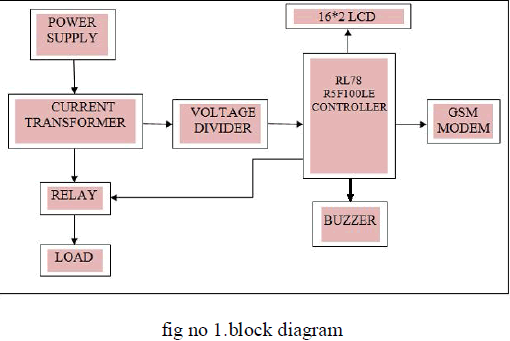 |
Functional Description Of Each Block: Current Transformer: |
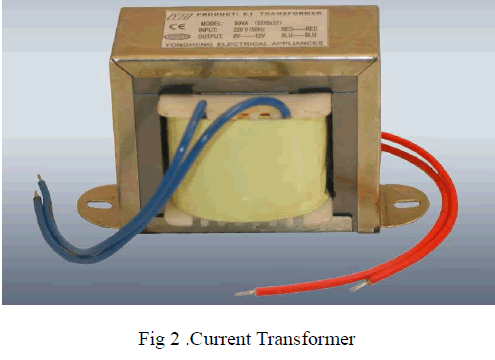 |
| When current in a circuit is too high to directly apply to measuring instruments, a current transformer produces a reduced current accurately proportional to the current in the circuit, which can be conveniently connected to measuring and recording instruments. A current transformer also isolates the measuring instruments from what may be very high voltage in the monitored circuit. Current transformers are commonly used in metering and protective relays. This transformer develops an electric voltage, which is proportional to load current and corresponding voltage is fed to controller unit for further calculation process and the conversions are handled by the controller itself. |
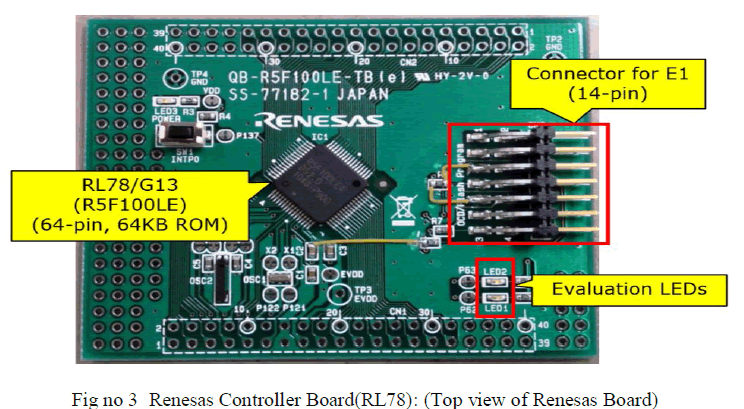 |
| Power unit: It mainly consists of DC jack followed by Bridge rectifier, capacitors, voltage regulators (317), current limiting resistors, power LED indicator and lastly connecting pins namely ground 5V, 12V. |
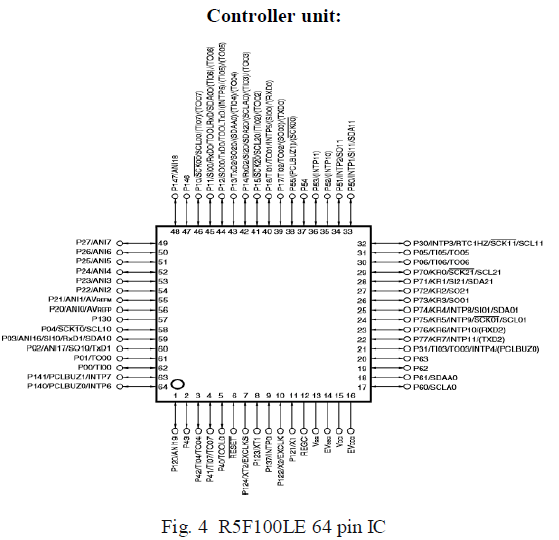 |
| We are using Renesas RL78 family’s R5F100LE controller. Its features are as follows: |
| General-purpose register: 8 bits × 32 registers (8 bits × 8 registers × 4 banks) |
| ROM: 512 KB, RAM: 32 KB, Data flash memory: 8 KB |
| On-chip high-speed on-chip oscillator. |
| On-chip single-power-supply flash memory (with prohibition of block erase/writing function) |
| On-chip debug function |
| On-chip power-on-reset (POR) circuit and voltage detector (LVD) |
| On-chip watchdog timer (operable with the dedicated low-speed on-chip oscillator) |
| I/O ports: 16 to 120 (N-ch open drain: 0 to 4) |
| Timer 16-bit timer: 8 to 16 channels, Watchdog timer: 1 channel |
| Different potential interface: Can connect to a 1.8/2.5/3 V device |
| 8/10-bit resolution A/D converter (VDD = EVDD =1.6 to 5.5 V): 6 to 26 channels |
| Power supply voltage: VDD = 1.6 to 5.5 V |
3.2.5 GSM Module: |
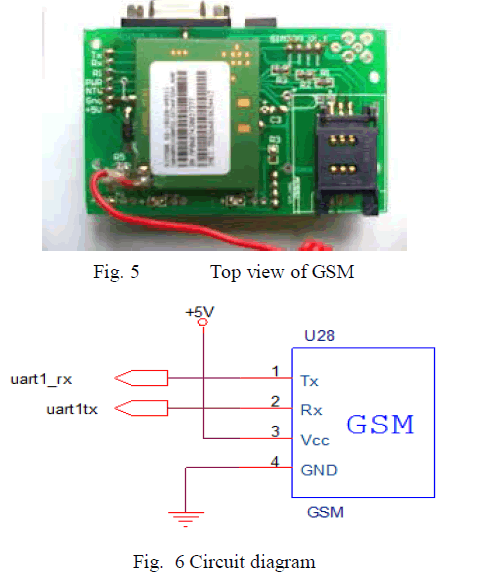 |
| GSM stands for Global System for Mobile Communications formerly called as Groupe Spécial Mobile. This is a standard set developed by the European Telecommunications Standards Institute (ETSI) to describe technologies for second generation (or "2G") digital cellular networks. The GSM standard initially was used originally to describe switched circuit network for full duplex voice telephony to replace first generation analog cellular networks The standard was expanded over time to include first circuit switched data transport, then packet data transport via GPRS(General packet radio service). Packet data transmission speeds were later increased via EDGE. The GSM standard is succeeded by the third generation (or "3G") UMTS standard developed by the 3GPP. GSM networks will evolve further as they begin to incorporate fourth generation (or "4G") LTE Advanced standards. "GSM" is a trademark owned by the GSM Association. One of the key features of GSM is the Subscriber Identity Module, commonly known as a SIM card. The SIM is a detachable smart card containing the user's subscription information and phone book. This allows the user to retain his or her information after switching handsets. Alternatively, the user can also change operators while retaining the handset simply by changing the SIM. Some operators will block this by allowing the phone to use only a single SIM, or only a SIM issued by them; this practice SIM300 is a Tri-band GSM/GPRS engine from SIMCOM Ltd., which works on frequencies EGSM 900 MHz, DCS 1800 MHz and PCS 1900 MHz. SIM300 features GPRS multi-slot class 10/ class 8 (optional) and supports the GPRS coding schemes CS-1, CS-2, CS-3 and CS- 4. With a tiny configuration of 40mm x 33mm x 2.85 mm , SIM300 can fit almost all the space requirement in an application, such as Smart phone, PDA phone and other mobile device. The physical interface between SIM300 and the mobile application is through a 60 pins board-to-board connector, which provides all hardware interfaces from module to customer’s boards except the RF antenna interface. |
| Load: We need to measure the number of units consumed depending upon the usage of power i.e load. To demonstrate the load consumption we have used incandescent bulbs of 60W and 100W. As the consumption of power is not constant throughout the is known as SIM locking. We are be using SIM300 GSM Module in our Paper.day; the calculation of load consumed for peak hours and normal hours are calculated. To calculate for peak hour consumption we use full load of 160W and for normal hours either 60 or 100watts is used. |
HARDWARE AND SOFTWARE DESCRIPTION |
| HARDWARE REQUIREMENT DETAILS: |
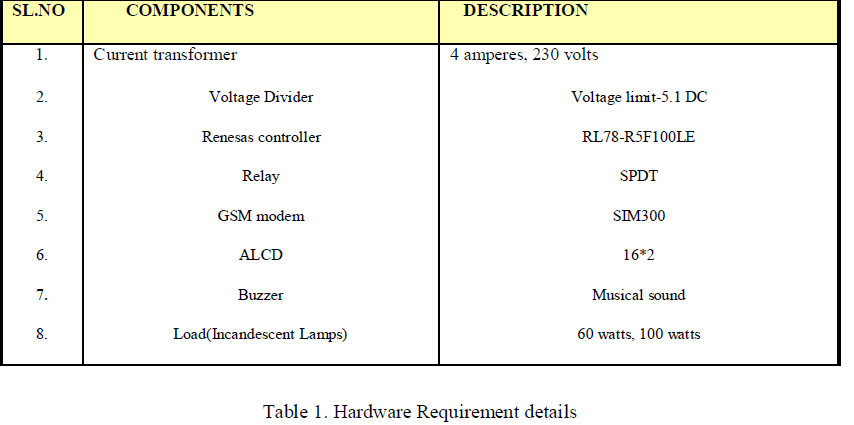 |
EXPERIMENTAL SETUP |
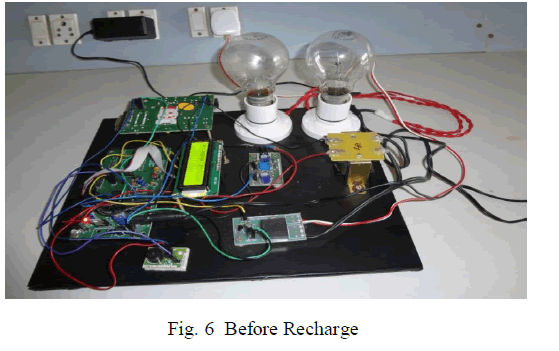 |
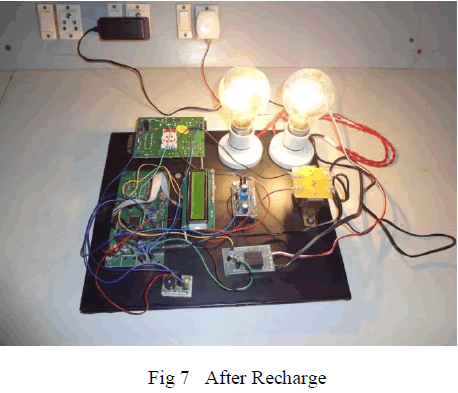 |
| WORKING PRINCIPLE: The block diagram consists of power supply section, renesas controller unit, Current transformer, voltage divider, relay unit, GSM modem.It is a simple illustration of how we have implemented our paper and the various parts involved in it. GSM is controlled by Renesas controller that controller sends signal to GSM to receive and transmit messages. The messages are recorded data of units consumed and the units left out to consume. Units are counted by a program in controller by fetching the voltage level of the load consumed. In our paper there is a system of calculation at normal load and peak load consumption which is maintained by Real time clock (RTC). RTC is inbuilt in renesas controller. Current Transformer converts load current into proportional voltage at secondary, which is proportional to load current. This is fed to voltage divider to get required minimized voltage. This voltage is fed as analog input to renesas controller in which voltage gets converted into corresponding digital value by ADC and stored in the memory. Software calculates value of energy by processing digital values. When the system is recharged, the display unit will display number of units remained to consume. When the recharge amount of energy reaches lower level, a message is sent to consumer that balance is low, recharge soon. Also buzzer is placed to know the low balance. When the balance is zero, the authority side will provide an extra unit to consumer considering if any inconvenience for consumer during recharge. Even after he fails to recharge in specified period, the KEB authority will disconnect the power supply immediately. When the balance becomes zero with provision if 1 extra unit, the controller gives signal to relay to trip, relay trips and power is cut. Again when the system is recharged, GSM gives signal to controller unit and relay re trips and supply is back to consumer. The amount for extra 1 unit provided by the authority is deducted in the next recharge amount. |
| SOFTWARE DETAILS: Cubesuite+: Cubesuite+ is an integrated development environment that provides an environment for developing microcontrollers from creation of pin lists to code generation, build and debug all in one total. Renesas Flash Programmer: When renesas is in hex file, we have to make use of Renesas flash programmer. |
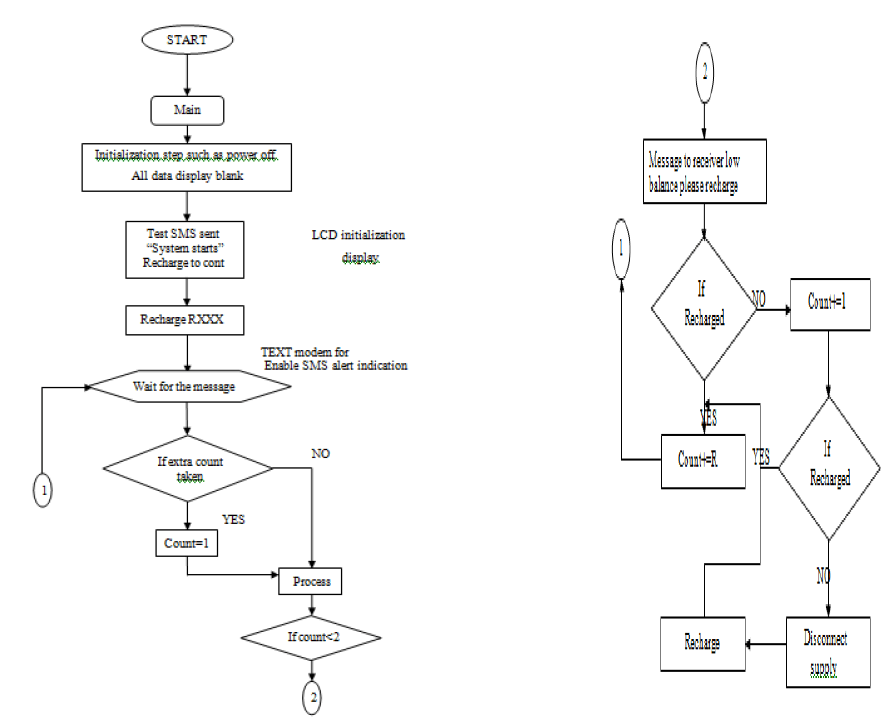 |
RESULT AND DISCUSSION |
| When the supply is provided to Adaptive Meter, initially LCD gets initialized. Test SMS is sent to consumer as “SYSTEM STARTS”. The Adaptive meter can be recharged by messaging from the registered KEB number to the GSM modem that is fixed with meter and user will get message that the energy meter has been recharged by some amount. In our Adaptive meter, we have set to recharge the amount up to Rs.999 (3 digits). The consumer can recharge the meter according to his requirement. If the consumer wants to know the left out balance in adaptive meter, can be checked in LCD display of Adaptive Meter. When the recharged amount reaches a minimum value i.e if Rs 10 left out to consume the power, the consumer gets a message that the balance is “Low balance recharge soon” and the adaptive meter gives a buzzer sound and this is repeated at Rs.5 and when no balance; the message is sent to consumer that “power cut due to no balance”, extra unit is provided in concern of the user. If the consumer fails to recharge before the specified period (even also after the usage of 1 extra unit provided by KEB), KEB authority will disconnect the supply such that the relay trips by receiving signal from controller and the supply gets disconnected then the message is sent to consumer that “power cut due to no balance”. The supply to customer is provided only after he recharges his energy meter. The amount for extra 1 unit provided by the authority is deducted in the next recharge amount. |
ADVANTAGES AND APPLICATIONS |
| 1. The adaptive meter designed reduces initial investment, complexity of circuit is reduced, where in a single system can perform both i.e. the calculation of units consumed and prepaid system of payment to authority for usage of power. |
| 2. Prepaid energy meter is used to improve the operational efficiency as there is no need of men for meter reading. |
| 3. The disconnection and reconnection of power supply is automatic. It can help to control appropriation of electricity in a better way than traditional metering. |
| 4. As the payment or recharge is through SMS, it improves the cash flows and also improved revenue management system, which reduces the financial risk. |
| 5. Customer service is also improved by using this. By the use of prepaid energy meter, the billing delay and extra cost due to disconnection or reconnection can be removed and we can use the electricity in a controlled manner which helps the consumer to save their money through better energy management. |
| Applications: It can be used as automated power billing in Homes, Commercial buildings, Small scale Industries, etc. The Adaptive meter which is designed can be installed in homes, commercial buildings and industries by making certain modifications as per the requirement in which both the suppliers and the consumers are provided with better services regarding meter billing and payment. |
CONCLUSION AND FUTURE SCOPE |
| Conclusion :In the present situation all customers are using manual communication. To reduce the manual efforts and human errors, we need to have some kind of automated system monitoring all the parameters and functioning of the connections between the customer and electricity board. Also by implementing this system we can control the usage of electricity on consumer side to avoid wastage of power. Since there is need to utilize energy in better and efficient way this pre-paid meter proves to be a boon in the power sector. In this system to save time of consumer, the consumed energy corresponding price is displayed for the consumer benefits. By the implementation of this system overall efficiency in operations of the electric board will improve. An attempt is made in this work to develop a system, which when interfaced with static electronic energy meter is avoided where in complexity of the circuit is reduced and cost also gets reduced of the meter. The consumers and the suppliers can be benefited by using the prepaid Adaptive meter in the following ways. |
| This system is of great advantage for the electricity department as this unit can be utilized effectively for preventing power theft, non-payment of electricity bills etc |
| The whole process of billing can be centralized. |
| Cost of manpower for billing / collection is reduced. |
| Future Scope: The same paper can be implementing by water supply department for controlling the usage of water and water billing system. It is hoped that this work helps the electrical engineers for better energy management and its utility in the distribution system for economic liability of the electrical companies. This method using GSM can be replaced by Zig Bee Technology which researches are going on it where in network problem can be mitigated from this technology. |
References |
|